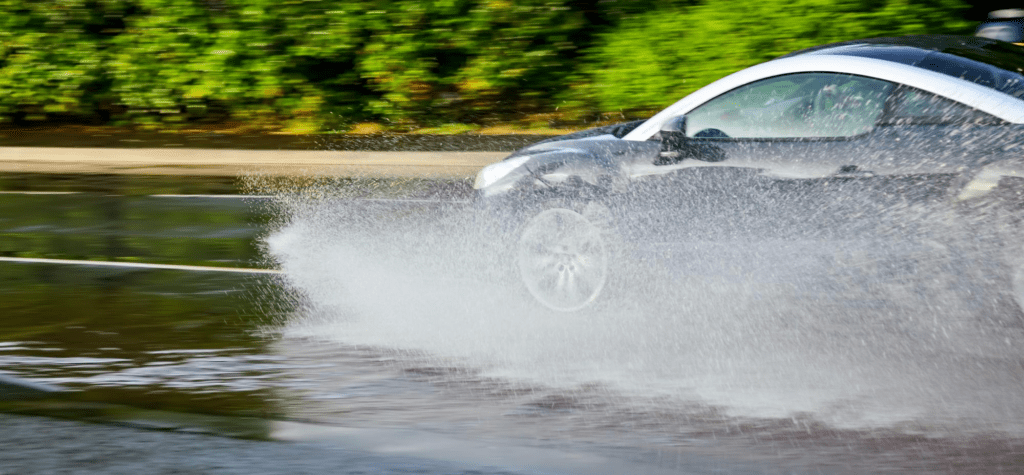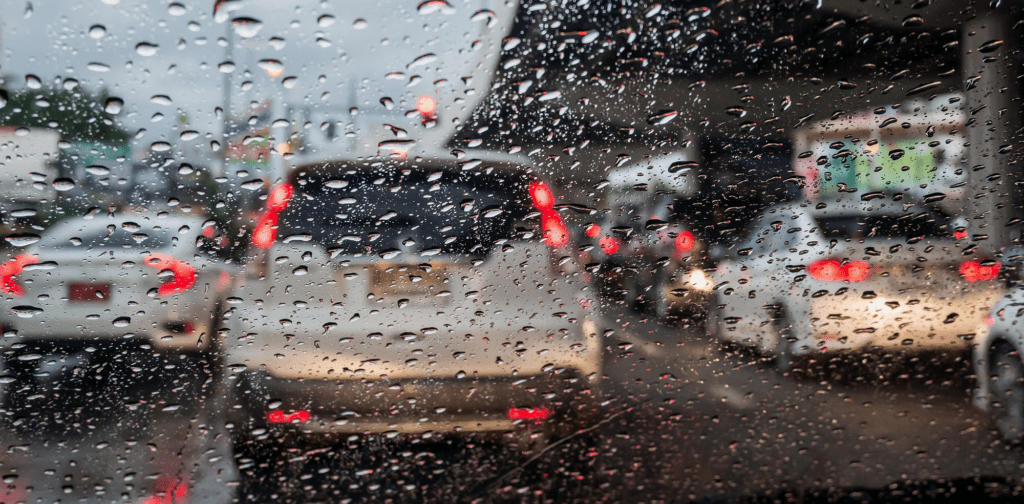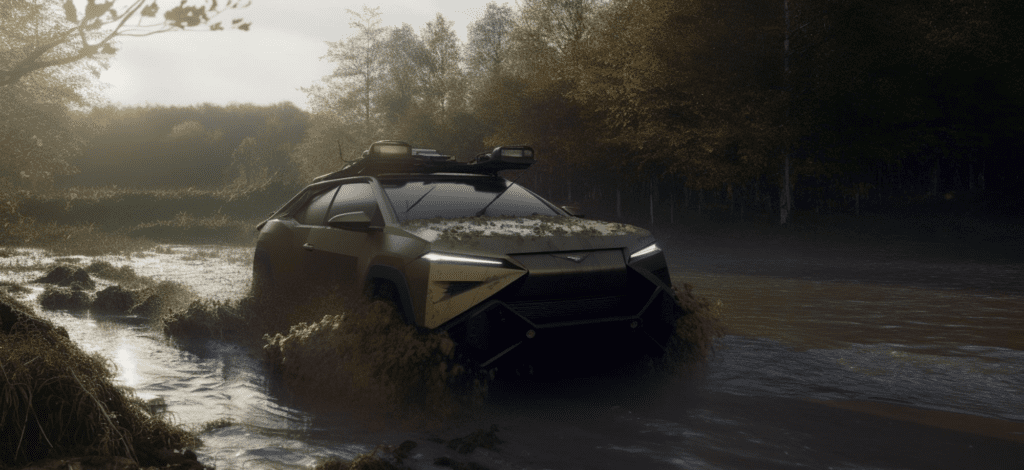
- What is meant by aquaplaning?
- When are you most at risk of aquaplaning?
- What does aquaplaning feel like?
- How do you avoid aquaplaning?
- How should you react to aquaplaning?
- What to do after driving through water
- Frequently asked questions
After a spell of heavy rain – a rather common occurrence in the UK – the only fool proof way to avoid driving through water is to lock up the car and stay at home. While this may be necessary during severe weather conditions or red weather warnings, there are times when you’ll need to venture out on the roads.
However, driving through floodwater not only poses a risk of damaging your engine and brakes but also carries a serious threat of aquaplaning. As much as it may sound cool or look impressive in movies, aquaplaning on public roads is undeniably frightening.
We’re here to provide you with essential guidance on how to react if you find yourself in a situation where you lose control, as well as effective measures to reduce the likelihood of aquaplaning. By following these tips, you’ll be better equipped to maintain control during such circumstances and minimize the chances of aquaplaning occurring in the first place.
What is meant by aquaplaning?
Aquaplaning, also referred to as hydroplaning occurs when water on the road creates a barrier between your vehicle’s tires and the solid ground. In this situation, the tires lose contact with the road surface, resulting in a loss of control over your car.
During aquaplaning, steering, accelerating, and braking become less effective, and you may experience the sensation of the back end of your car skidding or “fishtailing,” where it drifts sideways independently of your steering input.
What causes aquaplaning?
Aquaplaning occurs when you drive through water, particularly after a storm or heavy rainfall, and the water accumulates faster than your car can displace it. As a result, the excess water is forced underneath your tyres, causing them to lose contact with the road surface.
When are you most at risk of aquaplaning?
Aquaplaning poses a significant risk in certain situations where rainwater accumulates, such as:
-
Dips in the road: Depressions or areas of low elevation on the road surface can collect water, increasing the likelihood of aquaplaning.
-
Low-lying areas: Roads situated in low-lying regions or areas prone to flooding are more susceptible to standing water, which heightens the risk of hydroplaning.
-
Proximity to large bodies of water: Roadways near rivers or other significant water bodies have an increased chance of aquaplaning, especially during periods of heavy rainfall when the water levels rise and overflow onto the road surface.
-
Uneven road surfaces: Roads with uneven or worn-out surfaces, such as ruts or grooves, can trap water and create hazardous conditions for drivers, enhancing the potential for aquaplaning.
It’s important to note that standing water is often difficult to spot, and encountering it at higher speeds significantly increases the risk of hydroplaning.
Additionally, the condition of your tires plays a crucial role, as worn-out or improperly inflated tyres can decrease their ability to maintain traction on wet surfaces, further increasing the chances of aquaplaning.

What does aquaplaning feel like?
When aquaplaning occurs, the experience can be unsettling and comparable to skidding on ice. As a driver, there are certain signs that indicate you are aquaplaning while driving through water:
-
Lighter Steering: You may notice that your steering feels lighter and less responsive than usual. This is because the tires lose traction on the water-covered road surface.
-
Increased Engine Noise: The sound of your engine may become louder or higher in pitch. This is often due to the increased revs as the wheels spin without proper grip on the road.
-
Sudden Increase in Revs: Even without changing gears, you might observe a sudden rise in engine revs. This is a result of the loss of traction, causing the wheels to spin faster.
-
Rear End Fishtailing: Your vehicle’s rear end may start to fishtail or drift from side to side. This happens when the back wheels lose traction and slide independently of the front wheels.
It’s crucial to remain calm if you experience aquaplaning. Avoid any sudden or aggressive actions such as braking or turning sharply, as this can worsen the situation. Instead, gradually ease off the accelerator and maintain a steady course until your tires regain contact with the road surface.
How do you avoid aquaplaning?
While it’s best to avoid driving through floodwater whenever possible, we understand that it’s not always feasible to stay away from surface water on the roads. To help minimise the chances of losing control in such situations, consider the following tips:
Slow down
Reduce your speed when driving through wet conditions, especially during heavy rain or when approaching areas with standing water. Slower speeds allow your tyres to maintain better contact with the road surface, reducing the risk of aquaplaning.
Maintain proper tyre tread
Ensure your tyres have sufficient tread depth and are in good condition. Bald or worn-out tyres are more prone to hydroplaning as they lack the necessary grip. Regularly check your tire pressure as well, as underinflated tires can increase the risk of losing traction.
Avoid sudden actions
Try to keep your movements smooth and gradual when driving on wet roads. Avoid abrupt acceleration, braking, or sharp steering manoeuvres, as these actions can lead to loss of control. Gentle, controlled inputs allow your tires to maintain better contact with the road.
Increase the following distance
Leave a larger gap between your vehicle and the one in front of you. This provides extra time to react and adjust your driving if needed. It also reduces the risk of sudden braking, which can result in skidding or aquaplaning.
Use headlights and wipers
Turn on your headlights and use the appropriate setting on your wipers to improve visibility in rainy conditions. This allows you to see potential hazards on the road and react in a timely manner.
Be cautious of road conditions
Pay attention to any dips or low-lying areas where water is likely to accumulate. Also, be mindful of road surfaces that may be uneven or damaged, as they can increase the risk of aquaplaning.
By following these precautions and adjusting your driving behaviour, you can help minimise the risk of aquaplaning and maintain better control of your vehicle when encountering wet road conditions.
Remember, safety should always be the top priority when driving in challenging weather conditions.
How should you react to aquaplaning?
When faced with aquaplaning, it’s crucial to react calmly and effectively to regain control of your vehicle. Here are the key steps to follow:
Stay calm
It’s natural to feel startled or anxious, but it’s important to remain calm and focused. Panicking can hinder your ability to respond appropriately.
Ease off the accelerator
Release the accelerator pedal slowly and avoid sudden movements. This helps to reduce the risk of losing control further.
Maintain steering control
Keep your steering wheel straight and avoid making abrupt turns or corrections. This allows your tires to regain traction and stability.
Avoid harsh braking
Slamming on the brakes can cause your tyres to lock up and exacerbate the aquaplaning situation. Instead, gently apply the brakes once you start to regain control of the vehicle.
Regain control gradually
As you feel the tyres making contact with the road again, you can gradually increase steering input and brake more firmly to slow down if necessary. Remember to maintain a safe distance from other vehicles.
Learn from the experience
Take note of the conditions that led to the aquaplaning incident and adjust your driving behaviour accordingly. Reduce your speed when encountering standing water or wet surfaces to minimise the risk of aquaplaning.
By reacting calmly, staying focused, and following these steps, you can effectively handle aquaplaning situations and ensure your safety on the road.

What to do after driving through water
After driving through water, it’s important to take certain steps to ensure the safety and proper functioning of your vehicle. Here’s what you should do:
Check your brakes
Water can affect the performance of your brakes, so it’s crucial to test them after driving through water. Drive slowly in a low gear and gently apply pressure to the brake pedal to check if they are responsive. This will also help dry them out if they have become wet. Familiarise yourself with this process to know how to do it effectively.
Watch for stalling
If your vehicle stalls after exiting the water, it may indicate that water has entered your engine. In such a case, do not attempt to restart your car. It’s advisable to contact your emergency breakdown cover provider and arrange for a qualified mechanic to inspect and make your vehicle safe again.
Listen for engine changes
Even if your car doesn’t stall, listen attentively for any unusual changes in engine noise. If you notice any abnormal sounds or behaviour, it’s wise to have your engine checked over by a professional to identify and address any potential issues.
Check your lights
Verify that all your lights, including headlights, brake lights, indicators, and hazard lights, are fully functional. If any lights have become damaged or non-operational, have them repaired or replaced promptly.
Dry out footwell carpets
Water may have seeped into the footwells of your vehicle, particularly if there was a significant amount of water on the road. To prevent issues like mould growth and unpleasant odours, thoroughly dry out the carpets in your footwells. Use absorbent materials or consider using a wet/dry vacuum to extract the moisture.
By following these post-water driving precautions, you can identify and address any potential damage or issues and ensure that your vehicle remains safe and in good condition.

Frequently asked questions
It is crucial to exercise caution when driving through water to ensure your safety and the protection of your vehicle. Here are some guidelines to follow:
-
Avoid deep water: Never attempt to drive through water that is deeper than 10cm (4 inches). Deeper water can pose significant risks, such as engine damage, loss of control, or even the potential for your vehicle to be swept away in fast-moving water. It’s better to err on the side of caution and avoid driving through deep water altogether.
-
Beware of fast-moving water: Avoid driving through any depth of fast-moving water. Even relatively shallow water with a strong current can be hazardous and make it difficult to maintain control of your vehicle. If you encounter fast-moving water on the road, it is best to find an alternative route or wait until the water subsides.
-
Assess the situation: Before attempting to drive through a puddle, flood, or ford, carefully assess the depth and conditions of the water. Remember that water may be deeper in the middle, so it’s essential to gauge the situation accurately. If you are unsure whether your vehicle can safely navigate through the water, it is better to choose an alternative route or seek advice from authorities.
-
Prioritise safety: Your safety should always be the top priority. Taking unnecessary risks by driving through deep or fast-moving water can result in serious consequences, including damage to your vehicle, loss of control, or being stranded. It is better to exercise caution and make responsible decisions to avoid potential danger.
By following these guidelines and using your judgment, you can make informed decisions about driving through water and ensure your safety on the road.
If you notice that your car is sputtering or experiencing unusual noises after driving through water, it’s important to take immediate action to prevent further damage. Here’s what you should do:
-
Safely pull over: As soon as you notice any unusual symptoms from your engine, find a safe place to pull over. This will help prevent any further damage and ensure your safety.
-
Turn off the engine: Once you have pulled over, turn off the engine. This will help minimise the risk of any water entering critical components and causing more damage.
-
Assess the situation: Take a moment to assess the extent of the issue. Listen for any strange noises or observe any other signs of water ingress, such as a misfiring engine or difficulty in starting the car.
-
Contact a professional: It is recommended to seek the assistance of a qualified mechanic or call your breakdown provider. They will be able to assess the situation, diagnose the problem, and provide appropriate repairs or advice.
-
Avoid further attempts to start the car: It’s important not to attempt to start the car again, as this can potentially worsen the damage. Allow the professionals to handle the situation and provide the necessary repairs.
Remember, even a small amount of water entering your engine can cause significant damage. Acting promptly and seeking professional help will help prevent further complications and ensure that your vehicle is restored to proper working condition.
If your car gets stuck in water, it’s important to prioritise your safety and take the following steps:
-
Stay in your car: Unless there is an immediate risk of sinking or the water level is rising rapidly, it is generally safer to remain inside your vehicle. This is particularly true if the water is deep or fast-flowing. Exiting the car could put you at risk of being swept away or encountering other hazards.
-
Call for help: Use your mobile phone or any available means of communication to call for assistance. Contact emergency services or your breakdown provider to inform them of your situation. They will be able to provide guidance and arrange appropriate help.
-
Keep calm and assess the situation: While waiting for help to arrive, try to stay calm and assess the conditions around you. Observe the water level and any signs of danger. If possible, roll down the windows slightly to allow for ventilation.
-
Wait for assistance: It’s important to wait for professional assistance to arrive. They will have the necessary equipment and expertise to safely remove your vehicle from the water.
-
Avoid contaminated water: Keep in mind that floodwater can be highly contaminated with pollutants and bacteria. Avoid contact with the water as much as possible to prevent any health risks.
Remember, your safety is paramount. Trust the experts to handle the situation and provide the appropriate assistance.
When driving in heavy rain, it’s important to take additional precautions to ensure your safety on the road. Here are some key tips to follow:
-
Ensure good visibility: Turn on your headlights, even during the daytime, to increase your visibility to other drivers. This will also help you see the road ahead more clearly. Use your windshield wipers and defoggers to maintain a clear view through the windscreen.
-
Reduce your speed: Slow down and adjust your driving speed to match the road conditions. Wet roads can reduce traction, making it more difficult to control your vehicle. Slowing down allows for better control and gives you more time to react to any potential hazards.
-
Increase the following distance: Leave a greater distance between your vehicle and the one in front of you. This extended following distance will provide you with more time to brake safely if needed. It also reduces the risk of collisions due to reduced visibility or sudden braking.
-
Be cautious of standing water: Watch out for large puddles or areas of standing water on the road. Driving through these can cause hydroplaning or loss of control. If possible, try to navigate around them or drive through slowly and cautiously.
-
Avoid sudden manoeuvres: Make smooth and gradual movements when steering, accelerating, and braking. Avoid sudden manoeuvres, as they can lead to skidding or loss of control on wet surfaces.
-
Stay focused and alert: Pay close attention to the road and avoid distractions while driving in heavy rain. This includes avoiding the use of mobile devices or engaging in activities that may take your attention away from the road.
By following these guidelines, you can help ensure your safety and reduce the risk of accidents when driving in heavy rain.


